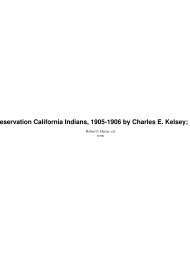“Parkitecture†68(2):3-5 by Charles Palmer - Yosemite Online
“Parkitecture†68(2):3-5 by Charles Palmer - Yosemite Online
“Parkitecture†68(2):3-5 by Charles Palmer - Yosemite Online
You also want an ePaper? Increase the reach of your titles
YUMPU automatically turns print PDFs into web optimized ePapers that Google loves.
Huangshan National Park<br />
tourist party to <strong>Yosemite</strong> Valley, has held a similar attraction<br />
to famous and amateur painters, writers, poets, and<br />
photographers, who are drawn to the same beauty that<br />
attracted Ansel Adams, Albert Bierstadt, William Keith,<br />
Thomas Moran, Helen Hunt Jackson, Thomas Wolf,<br />
Gertrude Stein, Frederick Law Olmsted, and John Muir.<br />
Although not twins, the two parks share enough to<br />
be biological “sisters.” Both are known for their granite<br />
peaks, precipitous cliffs and towering pines. While<br />
<strong>Yosemite</strong>’s El Capitan, Half Dome, and <strong>Yosemite</strong> Falls<br />
have become icons of grandeur in the natural world, Mt.<br />
Huangshan—the Emperor’s Mountain—has tremendous<br />
cultural significance to the people of China. Its landmarks,<br />
including Shixin Peak, Bright Peak, Sea of Clouds,<br />
Celestial Basking Shoe and Celestial Basking Boot (subjects<br />
of Taoist folk lore), Lotus Peak and Nine-Dragon<br />
Waterfall, have drawn pilgrims for millennia.<br />
Both parks are botanically rich. The strange Huangshan<br />
pines and the massive giant sequoia of the Sierra Nevada<br />
do not draw comparisons to each other, but individual<br />
specimens of each have stirred imaginations, inspiring<br />
names and characterizations. For example, on Mt.<br />
Huangshan there are the Guest-Greeting Pine, Guest-<br />
Good<strong>by</strong>e Pine, Phoenix Pine, Black Tiger Pine and Sea<br />
Exploring Pine; and, in <strong>Yosemite</strong> we gave the Grizzly<br />
Giant, the Fallen Monarch, the Bachelor and Three Graces,<br />
the Faithful Couple and the Four Guardsmen trees.<br />
Edifices constructed in each have acquired their own<br />
cultural significance. Much of the architectural style now<br />
known as “park rustic” or “parkitecture” was experimented<br />
on in <strong>Yosemite</strong>, a favorite park to Steven Mather,<br />
the National Park Service’s first director. At the end of the<br />
13th century, there were 64 temples scattered on slopes<br />
of Mt. Huangshan. The influx of hundreds of men of letters<br />
further enhanced the position of the mountain as the<br />
center of arts and spiritual life.<br />
Because of their locations in and near the major<br />
urban centers of Shanghai and San Francisco (which are<br />
sister cities), the natural and cultural resources of both<br />
face common pressures. The parks wish to increase their<br />
already substantial efforts toward the education of school<br />
children and the general public so that their country’s<br />
people can become committed partners in the conservation<br />
of the parks.<br />
The employees of both parks share the common ideals<br />
of stewardship and preservation of the resources in<br />
their care. Their highest priorities are to preserve natural<br />
biodiversity and maintain ecosystems and habitats; and<br />
to implement the research, inventory, and monitoring<br />
programs necessary to achieve success in these preservation<br />
and restoration efforts. To this end, <strong>Yosemite</strong> has a<br />
research and education partnership with the University<br />
of California at Merced and its Sierra Nevada Research<br />
Institute. The University of California and Sichuan<br />
University are establishing a reciprocal research program.<br />
This partnership will strengthen the sister park relation-<br />
PHOTO COURTESY OF WEI QIANG<br />
10 YOSEMITE ASSOCIATION, SPRING 2006




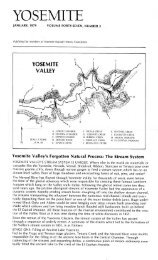
![(March 1982) [PDF] “We Are Pleased to Announce†- Yosemite Online](https://img.yumpu.com/51299748/1/190x242/march-1982-pdf-aeuroewe-are-pleased-to-announceaeur-yosemite-online.jpg?quality=85)
![[PDF] Old Horny, Yosemite's Unicorn Buck - Yosemite Online](https://img.yumpu.com/51269869/1/184x260/pdf-old-horny-yosemites-unicorn-buck-yosemite-online.jpg?quality=85)
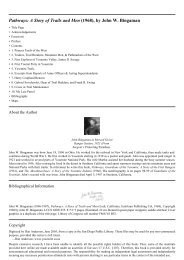
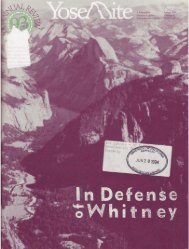
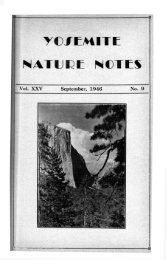
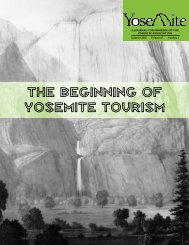
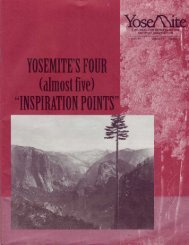
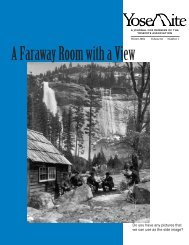
![1985 [PDF] - Yosemite](https://img.yumpu.com/48128837/1/184x260/1985-pdf-yosemite.jpg?quality=85)

